Incorporating fluid art into modern home décor is like splashing vibrant, swirling colors straight into your living space. Start with high-quality paints and bases like Rustoleum Seashell for that perfect pour. Experiment with colors; blues and silvers create calm vibes, while earthy tones soothe the soul. Let fluid art pieces take the spotlight on your walls or give your furniture striking new looks with swirls of colors. Gallery walls brimming with fluid art add depth and excitement to any room. And hey, even your coasters can become mini masterpieces. The artistry doesn't stop here—the next ideas will truly transform your spaces!
Key Takeaways
- Use fluid art as focal points by displaying large canvases in prominent areas.
- Create gallery walls with cohesive color palettes and mixed frame styles.
- Enhance furniture with fluid art designs, using complementary colors for seamless integration.
- Incorporate fluid art in textiles like cushions and throws to add visual interest.
Choosing the Right Materials
Selecting the appropriate materials is essential for achieving high-quality fluid art pieces that enhance home décor. The selection process begins with choosing high-quality paints, which are fundamental for creating visually stunning artwork. Brands like Golden's Paints, known for their vibrant colors such as Prussian Blue and Iridescent Silver, provide excellent options. These paints not only offer brilliant hues but also guarantee material durability, which is imperative for long-lasting art pieces.
In addition to paint selection, a good base coat is important. Rustoleum Seashell serves as an excellent foundation, making it easier to pour and creating a smoother surface for the fluid art technique. This initial layer aids in achieving a flawless finish, enhancing the overall aesthetic appeal of the piece.
Moreover, incorporating cell activators, like Amsterdam pouring medium mixed with titanium white, can introduce dynamic effects into the artwork. These activators help in forming intricate patterns and textures, adding depth and interest to the composition.
Understanding Color Combinations
After securing the right materials, the next step involves understanding color combinations to create fluid art that complements and enhances home décor. The art of color psychology plays a fundamental role here, as different hues evoke specific emotions and atmospheres.
For instance, complementary colors like Prussian Blue and Iridescent Silver can add visual interest and contrast, making a bold statement in modern interiors. Color harmony is essential to guarantee that the artwork integrates seamlessly with the surrounding décor.
Earthy tones such as Venetian Blue and Sapphire Blue are perfect for evoking a calming atmosphere, ideal for living spaces seeking tranquility. Adding shimmery colors like Restum's Harbor Sky can bring depth and dimension, transforming the artwork into an enchanting focal point.
Balancing vibrant and muted tones is critical to avoid overwhelming the space. Pair dynamic colors with neutral backdrops like Rustoleum Seashell to create a harmonious blend.
Experimenting with uneven lines and splatters can result in unique patterns that reflect personal style and individuality, assuring each piece stands out as a distinctive addition to modern décor. By mastering these elements, you can craft fluid art pieces that resonate with both aesthetic appeal and emotional depth.
Wall Art as Focal Points
Fluid art wall pieces often serve as enchanting focal points in modern home décor, drawing the eye with their vibrant colors and dynamic patterns. The use of artistic techniques, such as the swipe technique, creates unique, uneven lines and textures, adding layers of visual interest. These pieces can transform a plain wall into a mesmerizing display of movement and energy, making each artwork a one-of-a-kind addition to your home.
Utilizing a mix of colors, like Prussian Blue and Iridescent Silver, enhances the aesthetic appeal of a room by either complementing or contrasting with existing color schemes. This thoughtful color selection amplifies the visual impact of the piece, ensuring it stands out as a centerpiece.
Larger fluid art canvases deliver a dramatic impact, commanding attention and anchoring the room's décor. Meanwhile, smaller pieces can still make a significant impression, especially when grouped thoughtfully. The key to maintaining the artwork's sheen and vibrancy lies in using a quality pouring medium. This not only preserves the piece's brilliance but also reduces the need for additional varnishing, making it easier to maintain in a home setting.
Incorporating fluid art as focal points truly enhances modern home décor, blending creativity with striking visual elements.
Creating Gallery Walls
Creating a gallery wall with fluid art can be an exciting way to personalize your space.
Start by focusing on color coordination; choose pieces that not only stand out on their own but also complement each other and the room's overall palette.
Additionally, selecting the right frames—from sleek modern to rustic styles—can enhance the visual impact of your gallery wall, adding both character and cohesion.
Color Coordination Tips
Selecting a cohesive color palette that complements your existing decor is vital for creating a harmonious gallery wall with fluid art. By understanding color theory, you can choose shades that create balance and cohesion. For example, if your room is decorated in neutral tones, incorporating fluid art with vibrant blues can add a striking yet balanced contrast.
Color psychology also plays an important role in this process. Different colors evoke different emotions; for instance, blue can create a calming atmosphere, while red can energize a space. By selecting colors that not only look good together but also align with the mood you want to create, you can enhance the overall ambiance of your room.
Mixing sizes and shapes in your fluid art pieces adds visual interest and depth. Larger canvases can serve as focal points, drawing the eye, while smaller works fill in gaps and create a cohesive look. Intentional spacing is key—too much clutter can overwhelm, but well-placed pieces allow for a natural flow.
Pairing fluid art with other textures like photographs or textiles can also add layers and richness. Experimenting with these elements guarantees your gallery wall is dynamic and engaging.
Frame Selection Guide
Choosing the right frames is vital for enhancing the visual appeal and cohesion of your gallery wall. When creating a gallery wall, it's important to select frames that complement the color palette of your fluid art pieces. This guarantees a cohesive look that fits seamlessly into your home décor.
Consider using a mix of frame styles—modern, vintage, or rustic—to add visual interest. This variety can create a dynamic arrangement that showcases the unique textures and colors of your fluid art. Mixing frame styles doesn't mean it will look chaotic; instead, it brings a playful yet sophisticated touch to your space.
Frame sizes also play a significant role. Opt for larger frames for statement pieces and smaller ones for accent works. This variation can draw the eye and create a more engaging display. To further unify your gallery wall, use a consistent matting color across different frames. This allows the vibrant hues of your fluid art to stand out without clashing.
Before you start hammering nails, plan your layout on the floor. This step lets you make adjustments and confirm the arrangement feels balanced and inviting in the space. Happy decorating!
Enhancing Furniture Pieces
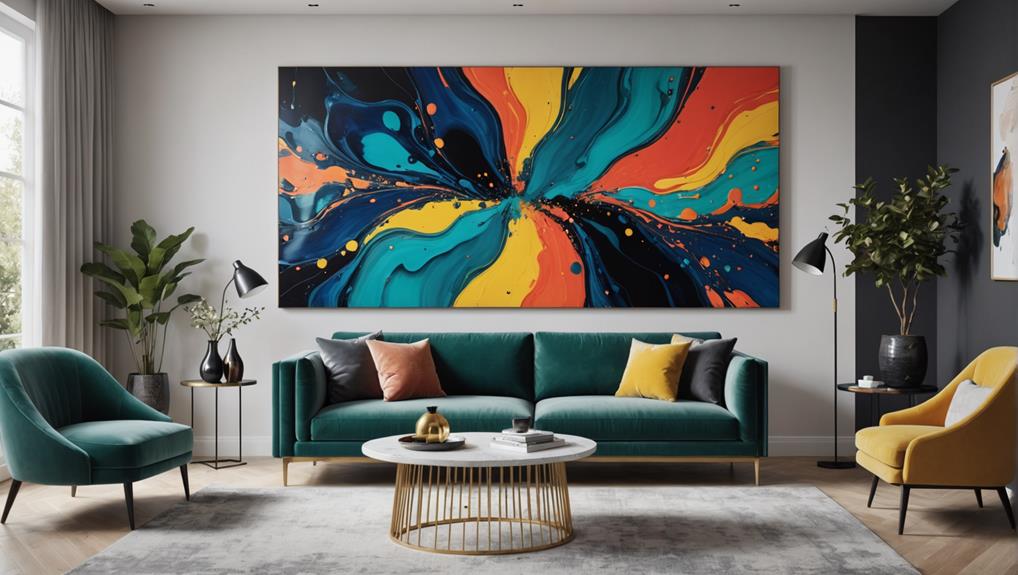
Incorporating fluid art into furniture pieces can transform ordinary items into stunning focal points.
By selecting colors that complement your existing decor, you guarantee that the artistic addition blends seamlessly with your room's aesthetic.
Applying a protective resin coating not only enhances the vibrancy of the design but also provides durability, making your furniture both beautiful and practical.
Choosing Complementary Colors
Considering existing furniture hues is vital when integrating fluid art into home décor to guarantee a harmonious and cohesive aesthetic. By understanding color psychology, you can select fluid art pieces that not only complement but also improve the overall vibe of your space. For instance, pairing Prussian Blue with earthy tones like Venetian Blue can create a serene and balanced look, while shimmery accents like Restum's Harbor Sky add depth and visual intrigue. This strategic use of color allows for artistic expression that boosts your furniture's appeal.
Fluid art's dynamic and vibrant patterns, created using techniques like the swipe method, can bring a lively contrast to clean-lined modern furniture. These uneven lines and splatters introduce a sense of movement and energy, making your furniture pieces stand out as focal points within the room. Evaluating the final drying results is essential to confirm that the sheen and vibrancy of the colors harmonize well with the textures and finishes of your furniture.
Experimenting with different color variations in your fluid art can lead to unique combinations that elevate your furniture's aesthetic. This thoughtful approach assures a cohesive and visually enchanting home décor.
Applying Protective Coatings
Applying protective coatings is an essential step to assure the longevity and visual appeal of fluid art on furniture pieces.
First things first, surface preparation is key. Make certain the surface is spotlessly clean and completely dry. This guarantees that the protective coating will adhere well and last longer. Imagine spending hours on your masterpiece only to see it fade or get scratched—no one wants that!
Now, let's talk about coating techniques. Choose a high-quality varnish or epoxy resin specifically designed for art applications. These products not only provide a durable, glossy finish but also protect against annoying scratches and harmful UV rays.
When applying the coating, patience is your best friend. Apply multiple thin layers rather than one thick layer. This helps prevent bubbling and unevenness, making your art look smooth and professional.
For large areas, a spray finish works wonders for achieving an even coat. Trust me, you don't want brush marks ruining your fluid art. But for detailed or intricate designs, a brush-on method is more effective.
Fluid Art on Coasters
Creating fluid art coasters involves using diverse pouring mediums and vibrant colors to craft unique, visually appealing pieces that enhance modern home décor. By experimenting with various coaster designs and pouring techniques, you can create functional yet decorative items that add a splash of creativity to any space.
Using a base like Rustoleum Seashell guarantees a smooth surface for easy color transfer. Vibrant hues such as Prussian Blue and Pain's Gray can be employed to achieve eye-catching designs. Additionally, the swipe technique is particularly useful for creating unique, uneven lines that add visual interest.
Incorporate shimmery pigments like Iridescent Silver and Restum's Harbor Sky to give your coasters a reflective quality, adding depth to the artwork. Confirming proper sealing with a resin or varnish is essential for both protecting the art and enhancing durability, making these coasters practical for everyday use.
- Pouring Mediums: Use Rustoleum Seashell for a smooth base.
- Color Choices: Include Prussian Blue and Pain's Gray for vibrant designs.
- Techniques: Experiment with the swipe technique for unique lines.
- Pigments: Add Iridescent Silver and Restum's Harbor Sky for shimmer.
Incorporating Table Tops
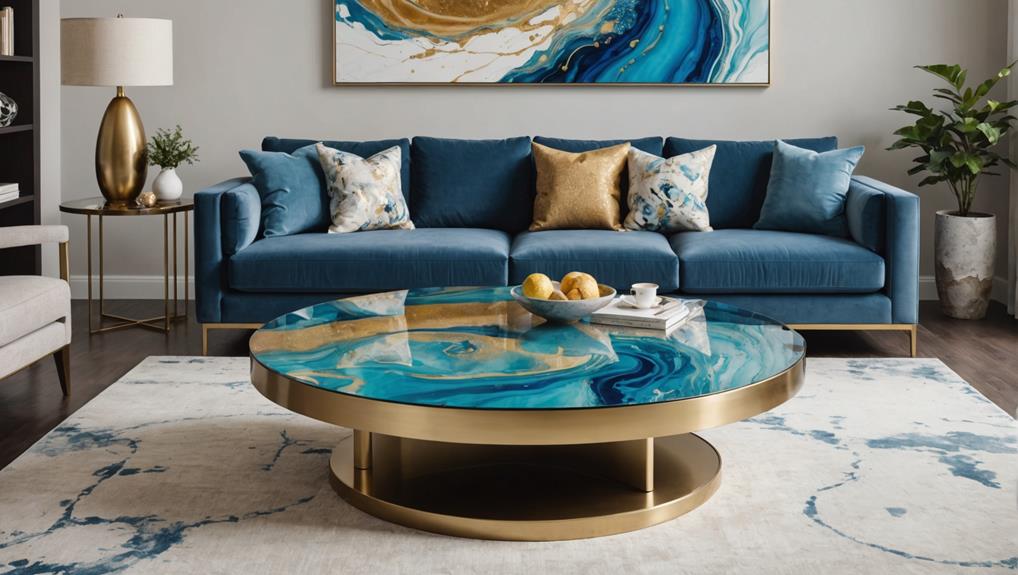
Fluid art can transform an ordinary table top into a stunning centerpiece by utilizing resin coatings that highlight vibrant colors and intricate patterns. Imagine sitting around a table that not only functions as a piece of furniture but also as a work of art. By incorporating fluid art into your table design, you can achieve this effortlessly.
Start by applying a base coat, such as Rustoleum Seashell, to guarantee a smooth finish. This coat will enhance the pouring process, making the vibrant colors pop even more. The swipe technique is particularly effective here; it creates unique, uneven lines and splatters, guaranteeing each table top is one-of-a-kind. You'll be surprised how these random patterns can serve as a conversation starter.
Resin techniques play an essential role in preserving the beauty of your fluid art table top. Choose a pouring medium that offers a lovely sheen, reducing the need for additional varnishing. This will help maintain the integrity of the artwork and guarantee its longevity.
Experimenting with complementary colors like Venetian Blue and Iridescent Silver can create a cohesive aesthetic, enhancing the overall decor of your space. By integrating these elements, your table top becomes more than just furniture—it becomes a statement piece.
Fluid Art Textiles
Integrating fluid art into textiles introduces an innovative blend of creativity and functionality, transforming everyday fabric items into enchanting works of art. This approach allows for vibrant colors and dynamic patterns to be infused into home decor, offering a personalized touch that reflects individual style and creativity. By employing fabric paint techniques such as pouring and swiping, one can create custom textile designs that are both unique and visually engaging.
High-quality fabric paints and mediums are essential to guarantee the longevity and vibrancy of these designs. These materials help the artwork withstand everyday use, maintaining their allure over time. Additionally, incorporating shimmery or metallic elements can further enhance the visual appeal of fluid art textiles, adding depth and dimension to any room.
Fluid art textiles can be applied to a variety of home decor items, bringing a sense of tranquility and creativity to personal spaces. Here are some ideas to get started:
- Curtains: Create an engaging focal point with custom-designed drapery.
- Wall Hangings: Transform blank walls into artistic expressions.
- Table Runners: Add a splash of color to dining tables.
- Bedspreads: Infuse bedrooms with unique, artistic designs.
Incorporating fluid art textiles into your home decor can truly uplift your living environment, making it a reflection of your artistic spirit.
Cushions and Throws
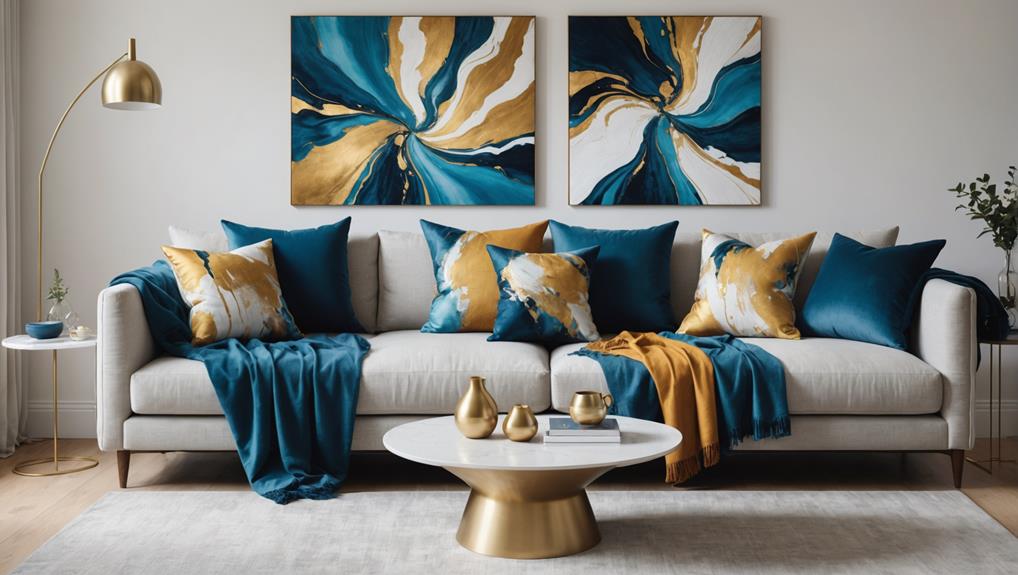
Adding cushions and throws with fluid art designs to your home decor can effortlessly enhance the visual interest and comfort of any living space. Fluid art cushions bring a vibrant and dynamic flair that showcases unique patterns and colors, elevating the aesthetic appeal of a room. The abstract nature of these designs means they can easily integrate into various color schemes, whether bold or neutral, making them versatile additions to any decor.
Fluid art throws are equally impressive, functioning as statement pieces on sofas or beds. They not only provide comfort but also add a touch of elegance, with their varying colors often sparking conversations among guests. These throws can transform a simple seating area into a focal point of the room.
Selecting cushions and throws made from high-quality materials is essential, as this guarantees their durability and longevity. This means the intricate fluid art designs will maintain their visual impact over time.
Furthermore, using fluid art in textiles allows for a personal touch in home decor, as each piece is often one-of-a-kind, reflecting the homeowner's unique style and creativity. This makes fluid art cushions and throws not just decorative items, but also expressions of individuality.
DIY Fluid Art Projects
Creating your own fluid art projects can be a rewarding way to personalize your home decor while exploring your artistic creativity.
Starting with a base coat, such as Rustoleum Seashell, guarantees a smooth surface for your color mixtures, facilitating a seamless flow and blending of colors. Fluid art techniques, like the swipe method, allow for dynamic patterns and textures; for instance, using paper towels to pull through paint can produce unique effects.
To enhance the visual appeal, consider using vibrant colors like Prussian Blue and Iridescent Silver, which reflect light beautifully. Incorporating a cell activator, made from Amsterdam pouring medium mixed with titanium white, can create fascinating cell formations and depth in your artwork. Once your piece dries, the natural sheen from the pouring medium often eliminates the need for additional varnishing, making it a low-maintenance decor option.
Here are some tips to get started:
- Use a base coat like Rustoleum Seashell for a smooth surface.
- Experiment with the swipe method using paper towels.
- Try vibrant colors like Prussian Blue and Iridescent Silver.
- Mix Amsterdam pouring medium with titanium white for cell activators.
Engaging in these DIY projects not only adds a personal touch to your space but also offers a fun and creative outlet.
Displaying Large Canvases
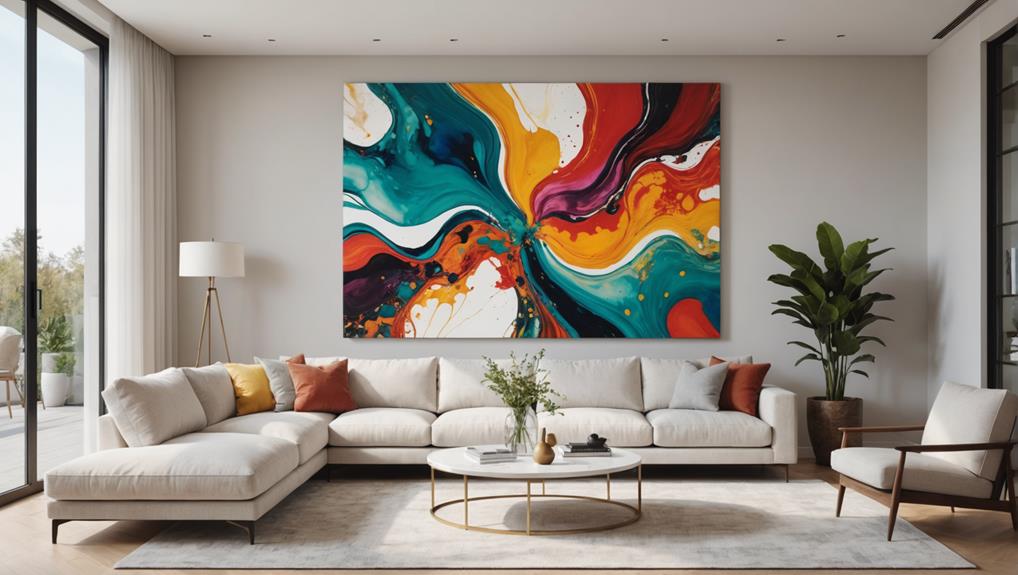
Large fluid art canvases can transform a room by serving as enchanting focal points that bring vibrant colors and dynamic patterns into modern home décor.
When pondering canvas placement, it's important to reflect on the surrounding elements. Neutral wall colors are ideal for enhancing the artwork's colors, allowing the fluid patterns to really pop. Positioning the canvas at eye level is key, as it creates a more engaging experience for viewers and integrates the art seamlessly into the room's design.
Lighting techniques play a vital role in showcasing these striking pieces. Using LED spotlights or track lighting can highlight the sheen and texture of fluid art, drawing attention to the unique details that make each piece special. Proper lighting can also enhance the overall atmosphere of the space, making the artwork an enchanting centerpiece.
In open concept areas, large fluid art can help define different spaces while maintaining a cohesive aesthetic. By using a consistent color palette that ties into the surrounding décor, you can create a harmonious flow throughout your home. This strategic placement not only showcases the beauty of fluid art but also brings a sense of unity and sophistication to your modern interior.
Small Art in Nooks
Strategically placing small fluid art pieces in nooks can enhance the visual appeal of a room, providing vibrant focal points that enrich the overall decor without overwhelming the space.
These compact artworks, such as 8×10 inch canvases or framed pieces, are perfect for tight spaces like shelves, mantels, or entryways, adding personality without taking up much room.
The vibrant colors and unique patterns of fluid art can complement various interior styles, from modern minimalism to bohemian chic, making them versatile decor options.
Incorporating fluid art in nooks can greatly improve nook aesthetics, while also making art accessibility easier for everyone in the household.
By using a cohesive color palette, you can tie together different elements of your decor, creating a harmonious look throughout the space.
Displaying fluid art in unconventional nooks, such as on top of books or inside shadow boxes, adds an element of surprise and intrigue.
- Small canvases fit snugly into tight spaces
- Vibrant colors complement various styles
- Cohesive color palettes create harmony
- Unconventional placements add intrigue
Fluid Art in Bathrooms
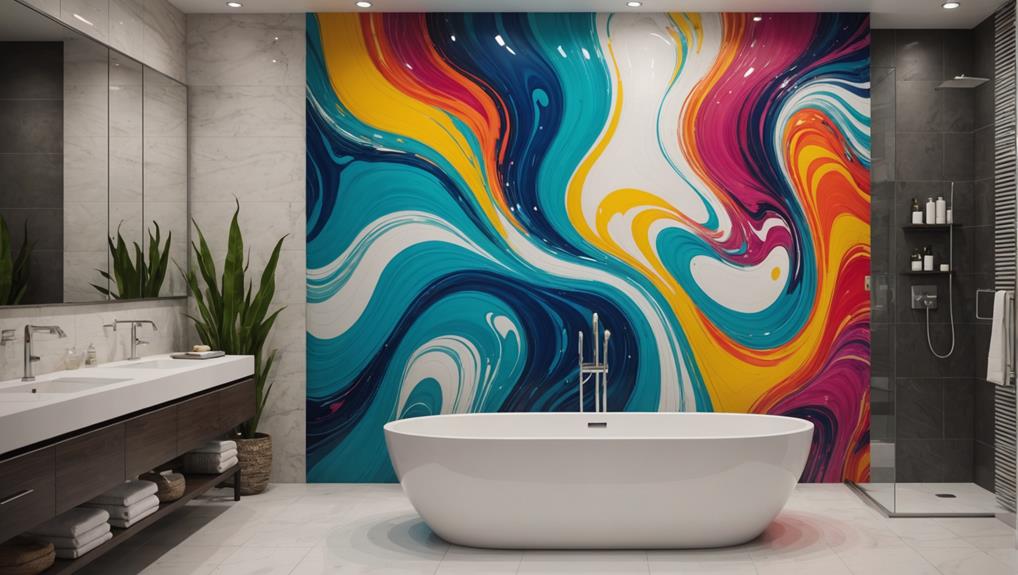
Building on the idea of enhancing small spaces, fluid art can also uplift bathroom decor by introducing serene, water-inspired aesthetics. By incorporating fluid art techniques, you can bring the calming elements of water into your bathroom, creating a visually enchanting atmosphere. The organic shapes and flowing colors typical of fluid art lend themselves perfectly to spaces meant for relaxation.
One effective way to incorporate fluid art is through canvases or prints that feature vibrant hues, such as blues and greens. These colors can enhance the spa-like feel of your bathroom, making it a more inviting space. Placing a striking fluid art piece above the bathtub or vanity can serve as a stunning focal point, drawing the eye and adding depth to the room.
For a cohesive design, select fluid art that complements your existing bathroom color schemes and materials, like tiles and fixtures. Additionally, you can apply fluid art techniques to functional items, such as coasters or trays, adding a pop of creativity while keeping the space practical.
This approach guarantees that your bathroom not only looks beautiful but also remains functional and harmonious.
Seasonal Fluid Art Decor
Incorporating seasonal fluid art decor into your home can create a dynamic and aesthetically pleasing environment that evolves with the changing seasons. By using colors and textures that align with seasonal themes, such as warm earthy tones for autumn or cool blues for winter, you can enhance the visual appeal of modern living spaces.
Fluid techniques, like the swipe method, enable the creation of unique patterns that perfectly complement these seasonal themes, making them incredibly versatile for various decor styles.
To achieve this, consider the following tips:
- Rotate Artworks Regularly: Display fluid art pieces in seasonal color palettes and rotate them to keep your decor fresh and dynamic.
- Incorporate Smaller Pieces: Use smaller fluid art items like coasters or table centerpieces, which can be easily swapped out to reflect the changing seasons.
- Utilize Pouring Mediums: Enhance the visual impact by using a pouring medium with a sheen, capturing light and creating a vibrant atmosphere.
- Align with Holidays: Choose colors and patterns that align with specific holidays, adding a touch of festivity to your decor.
Frequently Asked Questions
What Color Combinations Are Best for Fluid Art?
For fluid art, the best color palettes often include complementary colors such as Venetian Blue and Sapphire Blue with Prussian Blue, shimmery tones like Harbor Sky and Iridescent Silver, and gradients of Pain's Gray with white for elegant compositions.
What Can You Do Fluid Art On?
Fluid art can be applied on various surfaces, including canvas options, wood panels, and furniture. Proper surface preparation is essential to guarantee adhesion and durability, allowing for a wide range of decorative applications in home décor.
Can You Use Pouring Paint as Regular Paint?
Yes, pouring paint can be used as regular paint; however, its unique pouring techniques result in distinct textures and patterns. Additionally, this paint application often requires a sealant to guarantee durability and a glossy finish.
Can You Use House Paint for Fluid Art?
Yes, house paint can be used for fluid art, but it requires attention to house paint properties and may need thinning with pouring mediums to achieve suitable consistency for fluid art techniques, ensuring ideal vibrancy and sheen.
Conclusion
Integrating fluid art into modern home decor demands careful material selection, an understanding of color theory, and strategic placement.
Whether used as focal points or subtle accents, fluid art can transform spaces, enhancing furniture and creating dynamic gallery walls.
Displaying large canvases or smaller pieces in nooks, even in bathrooms, adds unique character.
Seasonal fluid art decor further personalizes the home, making fluid art a versatile and impactful design choice.

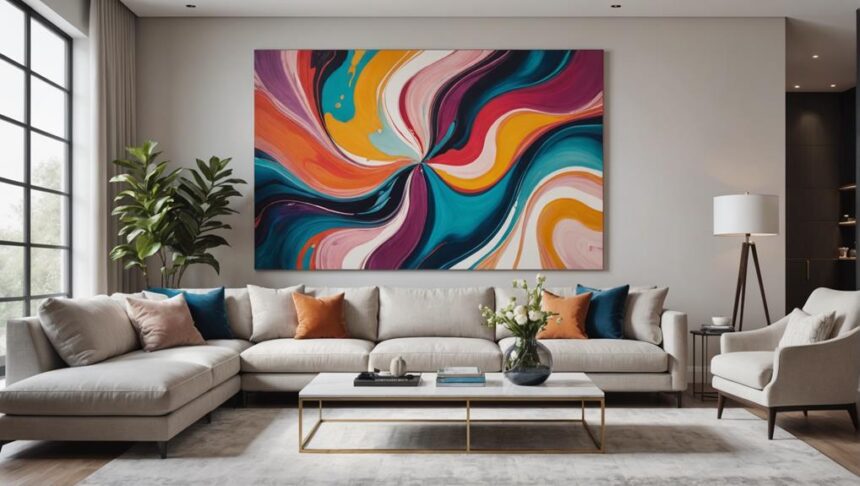
Leave a Reply